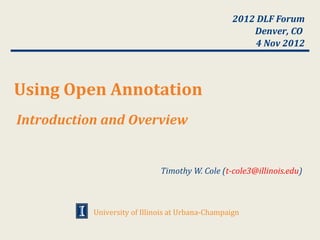
Cole using oa-intro-dlf2012
- 1. 2012 DLF Forum Denver, CO 4 Nov 2012 Using Open Annotation Introduction and Overview Timothy W. Cole (t-cole3@illinois.edu) University of Illinois at Urbana-Champaign
- 2. Scope • Premise: Annotation is a pervasive element of scholarship – How does past practice (on paper) translate to digital realm? – What kinds of new annotation practice is enabled? • Goal: A Web and resource-centric interoperable annotation environment that allows leveraging of annotations across the boundaries of annotation clients, annotation servers, and content collections • Timeline: – OAC Phase I funded by Andrew Mellon Foundation March 2009 – 1st OAC experiments begin Jan. 2011; 2nd group begin Fall 2011 – W3C Open Annotation Community Group Formed Dec. 2011 – Draft core & extension specs posted May 2012; 1.0 release by Jan. – Public rollouts spring 2013: East Coast, West Coast, Europe
- 3. The basic data model http://somewhere.edu/MyAnnotation Anno 1 – A resource of class oa:Annotation Anno 1 identified by a URI Res B – A resource Res T – A resource (any media type) (any media type) identified by a URI oa:hasBody oa:hasTarget identified by a URI (existing or new) Says Something Res B Res T About URN:uuid:1234567890 http://somewhere.edu/MyPage.html
- 4. Basic Annotation Model: W3C Open Annotation Community Group http://www.w3.org/community/openannotation/ From Open Annotation Core Data Model 9 May 2012 Draft (Beta) http://www.openannotation.org/spec/core/ Also Available: Open Annotation Extension Spec 9 May 2012 Draft (Beta) <Anno1> a oa:Annotation ; http://www.openannotation.org/spec/extension/ oa:hasBody <Body1> ; oa:hasTarget <Target1> .
- 5. Key Features • Support for expressing provenance (under review) – Both human and machine agents • Support for expressing motivation for annotating (new) – Commenting, questioning, agreeing / disagreeing, .... • Support for annotating segment or region of target – Also State (e.g., representation, version, ...) • Support for multiple targets (revised) – Multiple individual, choice/alternatives, set / cohesive whole, list • Support for annotation of targets in context (new) • Semantic & data annotations (revised) • Basic vocabularies for selectors, motivations, ...
- 7. Motivation (for annotating) Current Consensus 1. rdf:type •Every annotation MUST have an explicit class of oa:Annotation •Sub-classes of oa:Annotation may be used to restrict data model 2. oa:motivatedBy •To express reasons why the annotation was created •Proposed oa:Motivations: oax:Commenting, oax:Tagging, oax:Highlighting, oax:Asking, oax:Editing, ....
- 8. Specific targets & bodies Can express / constrain: •Source •State •Selector •Scope
- 9. Multiple targets / bodies Current Consensus •Multiple occurrences of the same predicate will be treated as "Individuals". Each body annotates each target completely and independently •Other constructions require explicit, typed nodes within the graph. –oa:Choice: Exactly one of the items in the Choice should be used. –oa:Set: All of the items in the Set should be used, and order is unimportant –oa:List: All of the items in the List should be used, and order is important. •These same classes will be used for Bodies, Targets and Specifiers. •Specifiers must use one of oa:Choice, oa:Set, oa:List
- 10. The OAC Experiments • U.of Queensland: Collaborative Development of Scholarly Editions • Stanford: Digitized Medieval Manuscripts • U. of Maryland: Streaming Video Content • U. of Illinois: Digital Emblematica • Cornell: Maphub Phase II • Brown: OAC Compliant Annotation Framework in Fedora • Meertens Inst: CATCHPlus Open Document Annotation • U. of Colorado: Annotation of Biomedical Text • NYU: Middleware for Scholarly Publications and Resources http://www.openannotation.org/Partners.html
- 11. Next • Andy Ashton • Jacob Jett • Kevin Livingston • Links (after the other presentations): – W3C Open Annotation Community Group http://www.w3.org/community/openannotation/ – Open Annotation Collaboration / Annotation Ontology Initiative http://www.openannotation.org/ http://www.openannotation.org/Partners.html http://code.google.com/p/annotation-ontology/ – Simple demo http://quest.grainger.uiuc.edu/OACDemo/Demo/Emblematica http://emblemimages.grainger.illinois.edu/meditationesembl00voge/emblem000012.xml • Use cases (from the audience)